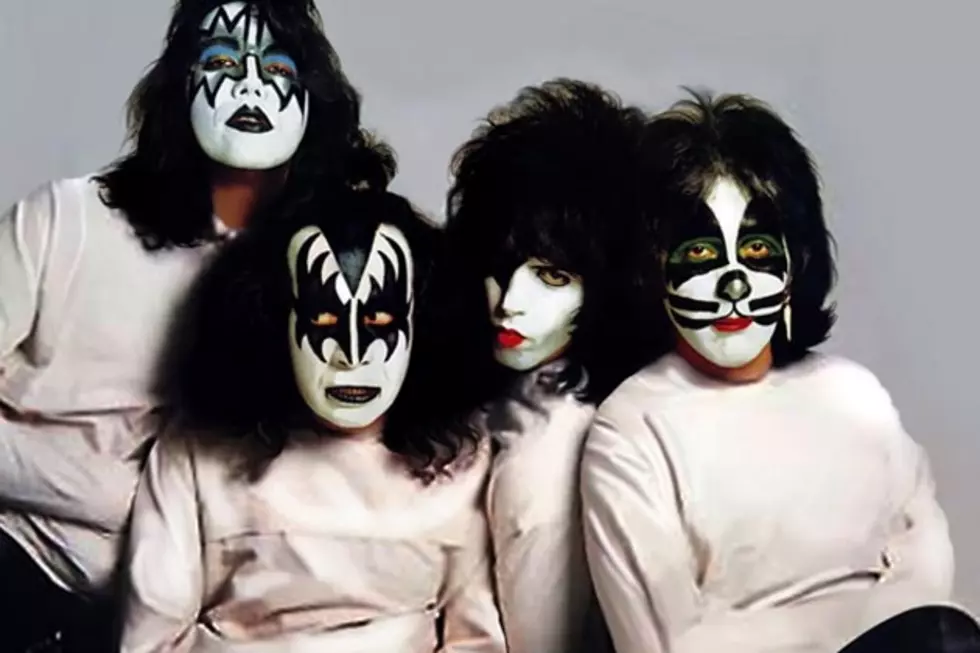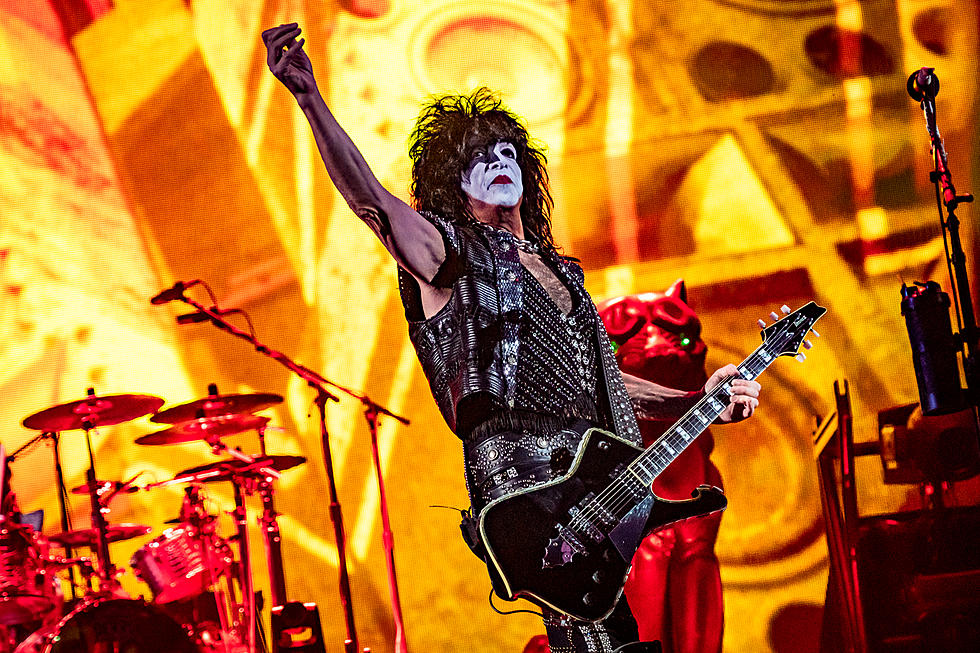
45 Years Ago: The Wheels Pop Off With Kiss’ ‘Dynasty’
The worst part was about Kiss' fall from grace in the late '70s and early '80s: They saw it coming. In fact, they did some pretty smart things to keep it from happening, or at least limit the damage. But their fates were sealed, and the first undeniable public sign of trouble showed up on May 23, 1979, in the form of their seventh studio album, the stylistically jumbled and ironically titled Dynasty.
In retrospect, the group's amazing ascension to the top of the music world earlier in the decade masked some pretty serious internal relations issues. As the stories of their heyday have emerged in numerous books and documentaries over the years, it's become pretty clear that the original lineup of Kiss was actually comprised of two very different sets of like-minded duos. At the risk of oversimplification or minimizing each of their very important contributions to the band's success, let's call them the hard workers (bassist Gene Simmons, guitarist Paul Stanley) and the hard-livers (drummer Peter Criss and lead guitarist Ace Frehley).
For a while, this fragile chemistry worked well enough to create the six studio albums and two live collections that remain the primary cause of the group's success and appeal decades later. Everybody knows the story by now: four broke guys from New York City paint their faces and then spend several grueling years touring non-stop with an incredible live show, while their questionably recorded studio albums fail to sell well. All this hard work resulted in the "overnight" 1975 success of "Rock and Roll All Nite" and the double-vinyl concert collection Alive!
READ MORE: Complete Guide to Kiss Lineup Changes
This breakthrough was followed, of course, by more touring, three more chart-topping (and better produced) albums – and yes, even more touring, this time to sold-out arena crowds snapping up Kiss T-shirts and lunchboxes and dolls and any other kind of merchandise the band could think to plaster their now-iconic painted faces on.
The only problem was, somewhere in the middle of one of those "and even more touring" jags, the band got really sick of each other.
Listen to Kiss Perform 'Hard Times'
The Problem With Four Simultaneous Solo Albums
Stanley and Simmons felt that Criss' and Frehley's substance abuse issues and general lifestyle choices were impeding their contributions to the band; one famous story had Ace skipping a recording session because he was at a card game. Meanwhile, Criss and Frehley felt their bandmates were too controlling, and holding them back creatively. Even as the band's popularity was reaching still greater heights at the end of 1977 -- with the release of the multi-platinum double-live sequel Alive II -- both Frehley and Criss expressed a desire to leave the band and start their solo careers.
But instead of splitting up, the group would take a break. Each member would prepare a solo album to be released as part of a coordinated marketing campaign, with all four records coming out on the same day complete with matching album covers and of course, the Kiss brand name.
The thinking seems clear: Everybody gets some breathing room, and gets to have things their way in the studio for a while. But ultimately, they realize that they have a unique chemistry together, and that it's much easier to succeed as part of a team. Then before you know it, it's time for the newly re-dedicated Kiss to crank the album-making, touring and merchandising machines back up to full speed with big smiles on their faces.
All four Kiss solo albums came out on Sept. 18, 1978. But new problems began to emerge right away. It became clear Kiss overload had kicked in with some portion of the record-buying public, who had also been asked to purchase a greatest hits album (Double Platinum) just five months earlier. Although each of the solo records sold about a half-million copies, their label had printed up twice that many, costing them a small fortune and making a bad impression on record stores across the world.
More importantly, as Stanley explained in his 2014 autobiography Face the Music: A Life Exposed, the most the solo albums did in terms of keeping the band together was to put "a Band-Aid on a gaping wound. They put off something that was inevitable."
Ace Frehley Discusses Recording 'Dynasty'
Kiss' Internal Problems Begin to Surface
Actually, they might have done more damage than that, particularly with regard to Criss. When it came time for Kiss to reunite in the studio, the Catman immediately ruffled feathers and dashed any sense of a new unity by insisting that the producer of his solo album, Vini Poncia, be hired to produce Dynasty. As Criss explained in his book Makeup to Breakup, that move backfired big-time. "Paul immediately went to work on Vini. They started hanging out, Vini moved into Paul's apartment, and Paul poisoned Vini against me."
Whether or not that's true, what did happen was that Kiss and Poncia decided Criss wasn't even fit to play on the album. Session drummer Anton Fig (who played on Frehley's solo album) filled in on every track except "Dirty Livin'," Criss' lone vocal showcase. Fig's participation was uncredited, with Criss appearing on the album's cover and joining the band on the ensuing tour, but the wheels were greased for his departure from the group the following year.
On the flip side, Frehley was able to leverage the critical and commercial success of his solo album – definitely the best of the bunch, and featuring "New York Groove," the biggest single from any of the records – into more songwriting and singing space. In addition to tackling a straight-ahead cover of the Rolling Stones' "2000 Man," Ace contributed two original songs to Dynasty: the semi-autobiographical and extremely catchy "Hard Times," and the album-closing "Save Your Love." "Everybody wanted to get as many songs as they could, everybody wants to shine for the fans." Frehley told us in a 2014 interview. "But pretty much the producer has the final say, usually. It's the ones with the best songs that get on the record."
READ MORE: Ace Frehley's Best Post-Kiss Songs
That put him one up on the normally heavily-represented Simmons, who managed only two rather lackluster contributions: "Charisma" (which unabashedly asks "What is it about me that gets you so hot?") and the self-explanatory "X-Ray Eyes." The extra-juvenile lyrics on these songs could be forgiven if the music was up to his usual standards, but as Simmons himself confessed in Kiss: Behind the Mask, "I think we lost the sense of what we were about. It was a guitar band and all of a sudden synthesizers started to appear. We thought that it wasn't enough to be just a rock 'n' roll band, which is a big mistake actually."
Yes, this is where the dreaded "D" word turns up in our tale.
Disco was sweeping the music world, and among the celebrities you could find dancing up a storm at New York's ultra-trendy Studio 54 was none other than Paul Stanley. It gave him the idea for what became one of Kiss's biggest – and most divisive – songs. "I had heard all these 126-beats-per-minute-songs and listened to the lyrics and thought, 'Gee, I can do that.'" he remembers in Face the Music. "I went home and set a drum machine to 126 bpm and sat down and started 'I Was Made for Lovin' You.'"
Watch Kiss Perform 'I Was Made For Lovin' You'
Kiss Endures a Disco Backlash
Imagine the sugar shock that hardcore Kiss fans who fell in love with the distorted rock of "Black Diamond" and "Detroit Rock City" must have felt when they first heard the bubbling bass, dance rhythms and Bee Gees-style cooing of this song. "I Was Made for Lovin' You" was, as a defiant and unapologetic Stanley puts it, "undeniable," and deservedly became a massive radio hit across the globe. The album's second single, "Sure Know Something," might be even better, successfully blending many of the same disco and pop influences with just enough of the band's usual guitar crunch.
Regardless of the quality of those singles, the radical style shift they presented – along with the spotty nature of the rest of the album – helped further alienate many of the band's once-mighty "Kiss Army." After all, they were already a bit burned out by the non-stop parade of albums and merchandise, to say nothing of the increasingly family-friendly image the group was portraying with projects like the corny TV movie Kiss Meets the Phantom of the Park.
Kiss was also about to get a harsh lesson in the difference between the fans who buy pop singles and those who go to rock concerts. The band confidently built a massive and expensive new stage show for the Dynasty Tour, then received a rather cold shock when the expected crowds didn't turn up. "It wasn't a good omen when our first show was cancelled," Stanley dryly notes in Face the Music. "We had already had a few two- and three-night stands on our last tour, in 1977, so what was next? More nights, obviously. Nope. Fewer. The bottom got pulled right out from under us. Instead of getting bigger, we were getting smaller."
The tour was marred by more in-fighting (with Criss nearly getting fired after deliberately slowing down the tempo following an on-stage argument with Stanley), and technical problems ("We spent years in court trying to get our money back for that laser curtain.") But Stanley realized the biggest problem while watching a crowd full of kids and families file into one of their shows from his hotel room across the street. "I looked out the window and broke into a cold sweat... the line could just as easily have been for the circus. We had sanitized ourselves and were well on our way to extinguishing the fire that had propelled us so far."
Although Frehley would hang around for two more albums as Kiss fell further and further into a career tailspin that wouldn't right itself until 1983's Lick it Up, it's not hard to see his closing verse on Dynasty, from the song "Save Your Love" and supposedly aimed at an ex-girlfriend, as a farewell to the golden era of Kiss if not the band itself:
"You know it's over. We had some good times, but now they're gone. So long..."
20 B-Sides That Became Big Hits
Gallery Credit: Nick DeRiso
Kiss Released One of Rock’s Most Hated Albums
More From Ultimate Classic Rock









